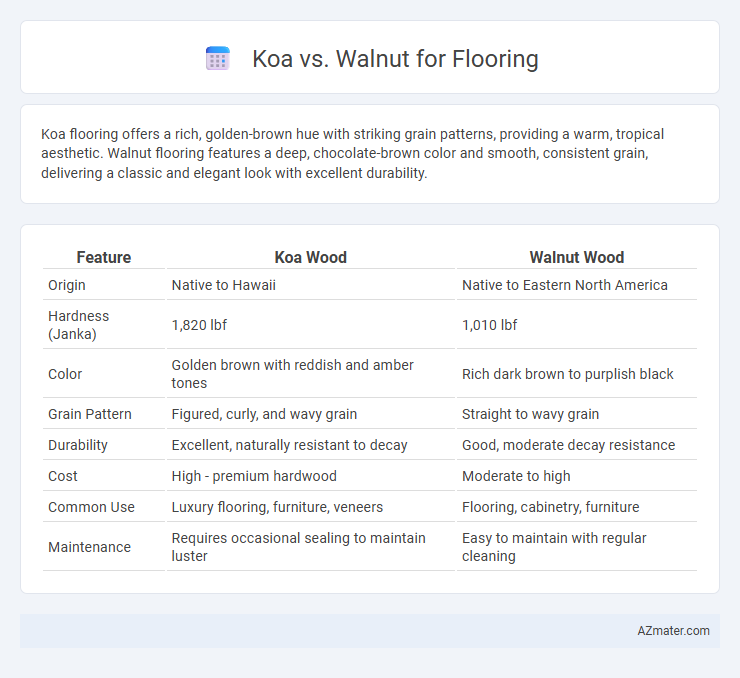Koa flooring offers a rich, golden-brown hue with striking grain patterns, providing a warm, tropical aesthetic. Walnut flooring features a deep, chocolate-brown color and smooth, consistent grain, delivering a classic and elegant look with excellent durability.
Table of Comparison
| Feature | Koa Wood | Walnut Wood |
|---|---|---|
| Origin | Native to Hawaii | Native to Eastern North America |
| Hardness (Janka) | 1,820 lbf | 1,010 lbf |
| Color | Golden brown with reddish and amber tones | Rich dark brown to purplish black |
| Grain Pattern | Figured, curly, and wavy grain | Straight to wavy grain |
| Durability | Excellent, naturally resistant to decay | Good, moderate decay resistance |
| Cost | High - premium hardwood | Moderate to high |
| Common Use | Luxury flooring, furniture, veneers | Flooring, cabinetry, furniture |
| Maintenance | Requires occasional sealing to maintain luster | Easy to maintain with regular cleaning |
Introduction to Koa and Walnut Flooring
Koa flooring, sourced from the native Hawaiian Acacia koa tree, is prized for its rich grain patterns and warm, golden-brown hues that deepen with age. Walnut flooring, derived from American black walnut, offers a smooth texture with deep chocolate to rich brown tones, creating an elegant and timeless aesthetic. Both woods provide durable, high-quality flooring options renowned for their unique character and long-lasting performance.
Appearance and Grain: Koa vs Walnut
Koa flooring features a rich, golden-brown hue with striking reddish undertones and a highly figured grain pattern that includes curly, wavy, and interlocked textures, creating a visually dynamic surface. Walnut flooring offers a deeper, chocolate-brown color with occasional purplish tones and a more consistent, straight grain that provides a classic, elegant appearance. Koa's vibrant and varied grain patterns make it ideal for accent pieces and statement floors, while walnut's subdued and uniform grain enhances traditional and sophisticated interior designs.
Durability and Hardness Comparison
Koa wood offers a Janka hardness rating of approximately 1,180, providing moderate durability suitable for residential flooring with a warm, amber tone that ages gracefully. Walnut ranks lower in hardness, around 1,010 on the Janka scale, making it more susceptible to dents and scratches but prized for its rich, dark color and smooth grain. For flooring applications requiring higher resistance to wear and impact, Koa's greater hardness offers enhanced longevity compared to the softer walnut.
Installation and Maintenance Requirements
Koa flooring typically requires professional installation due to its density and hardness, which can complicate cutting and fitting, while walnut is softer and more forgiving, allowing for easier DIY installation. Maintenance for koa involves regular cleaning with a damp mop and occasional refinishing to preserve its rich color and grain, whereas walnut demands more frequent polishing and careful humidity control to prevent scratching and warping. Both woods benefit from protective coatings, but koa's superior durability generally reduces long-term maintenance efforts compared to walnut.
Cost and Availability of Materials
Koa wood flooring generally commands a higher price due to its rarity and the limited availability primarily from Hawaii, making it a premium choice for luxury interiors. Walnut flooring offers a more cost-effective alternative with broader availability across North America and Europe, facilitating easier sourcing and lower material expenses. Both woods provide durability and aesthetic appeal, but budget-conscious projects benefit from walnut's accessibility and competitive pricing compared to koa's exclusivity and premium cost.
Sustainability and Environmental Impact
Koa wood, harvested primarily in Hawaii, offers greater sustainability due to reforestation efforts and controlled harvesting compared to walnut, which is often sourced from older, slower-growing forests with less regenerative management. Walnut flooring typically involves higher environmental impact due to extensive logging and longer growth periods, causing slower replenishment rates and habitat disruption. Choosing koa supports sustainable forestry practices and reduces carbon footprint by utilizing locally managed resources with a focus on ecosystem preservation.
Comfort and Insulation Properties
Koa wood offers exceptional warmth and natural insulation, making it a comfortable choice for flooring in cooler climates due to its moderate density and fine grain structure. Walnut flooring provides good thermal insulation but tends to be denser and cooler underfoot compared to Koa, which may affect comfort levels in cold environments. Both woods have unique appeal in terms of comfort and insulation, with Koa often preferred for its softer, warmer feel and Walnut valued for its durability and rich appearance.
Best Applications for Each Wood Type
Koa wood, prized for its rich golden to reddish hues and fine grain, excels in high-end flooring applications where visual impact and luxury are paramount, such as in residential living rooms or custom commercial spaces. Walnut flooring offers durability and a deep chocolate-brown color that suits both traditional and modern interiors, making it ideal for high-traffic areas like hallways and offices due to its resistance to wear. Selecting koa for aesthetic appeal or walnut for resilience ensures optimal performance and beauty tailored to specific flooring needs.
Resale Value and Long-Term Performance
Koa flooring offers higher resale value due to its rarity and rich, warm tones, making it highly sought after in luxury real estate markets. Walnut, known for its durability and resistance to wear, ensures superior long-term performance with minimal maintenance requirements. Both woods provide excellent investment potential, but Koa's exclusivity typically drives greater appreciation over time.
Which Flooring is Right for Your Home?
Koa flooring offers a rich, warm tone with distinctive grain patterns, ideal for creating a luxurious and tropical aesthetic in your home. Walnut flooring provides a deep, chocolate-brown color with excellent durability and a classic, timeless appeal suitable for high-traffic areas. Choosing between Koa and Walnut depends on your preferred style, budget, and how much wear resistance you need for your specific living spaces.

Infographic: Koa vs Walnut for Flooring
 azmater.com
azmater.com